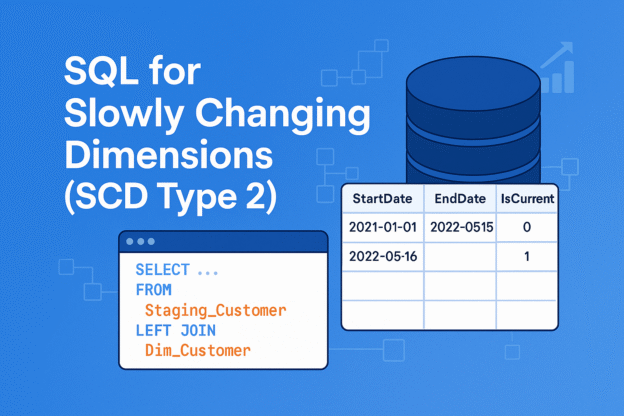When building data warehouses, you’ll often face a classic challenge: how to track changes in dimension data over time. For example, what if a customer moves to a new city? Should you overwrite their old address or keep the historical record?
That’s where Slowly Changing Dimensions (SCD) come in. In particular, SCD Type 2 is one of the most commonly used methods because it allows analysts to maintain historical accuracy while still tracking current data.
In this article, we’ll explain what SCD Type 2 is, why it’s important, and provide step-by-step SQL examples you can adapt to your own BI projects.
What is SCD Type 2?
A Slowly Changing Dimension (SCD) is a technique used in data warehousing to handle changes in dimension attributes over time.
- Type 1: Overwrites old data (no history kept).
- Type 2: Keeps history by creating new records when changes occur.
- Type 3: Keeps limited history using extra columns (e.g., “previous city”).
👉 SCD Type 2 is the go-to method when historical tracking is required, such as for compliance, customer analytics, or trend analysis.
Example Scenario
Imagine you have a Customer Dimension table:
| CustomerID | CustomerName | City | StartDate | EndDate | IsCurrent |
|---|---|---|---|---|---|
| 101 | Alice Brown | New York | 2021-01-01 | 2022-05-15 | 0 |
| 101 | Alice Brown | Chicago | 2022-05-16 | NULL | 1 |
- Alice moved from New York to Chicago in May 2022.
- Instead of overwriting the city, SCD Type 2 keeps both versions, with dates showing when each record was valid.
Key Columns for SCD Type 2
To implement SCD Type 2 in SQL, you typically add these fields to your dimension table:
- StartDate – when the record became effective.
- EndDate – when the record stopped being valid (NULL if still current).
- IsCurrent (flag) – 1 for current record, 0 for historical.
SQL for SCD Type 2
Step 1: Identify New and Changed Records
You’ll usually compare the staging table (new data load) with the dimension table (existing data).
SELECT s.CustomerID, s.CustomerName, s.City
FROM Staging_Customer s
LEFT JOIN Dim_Customer d
ON s.CustomerID = d.CustomerID
AND d.IsCurrent = 1
WHERE d.CustomerID IS NULL
OR s.City <> d.City;
This query finds new customers or existing customers whose city has changed.
Step 2: Expire Old Records
When a change is detected, mark the old record as expired.
UPDATE Dim_Customer
SET EndDate = GETDATE(),
IsCurrent = 0
FROM Dim_Customer d
JOIN Staging_Customer s
ON d.CustomerID = s.CustomerID
WHERE d.IsCurrent = 1
AND s.City <> d.City;
Step 3: Insert New Records
Insert the updated record with a new StartDate and set it as current.
INSERT INTO Dim_Customer (CustomerID, CustomerName, City, StartDate, EndDate, IsCurrent)
SELECT
s.CustomerID,
s.CustomerName,
s.City,
GETDATE() AS StartDate,
NULL AS EndDate,
1 AS IsCurrent
FROM Staging_Customer s
LEFT JOIN Dim_Customer d
ON s.CustomerID = d.CustomerID
WHERE d.CustomerID IS NULL
OR s.City <> d.City;
Best Practices for Analysts & BI Teams
- Use surrogate keys (e.g., DimCustomerKey) instead of relying only on business keys.
- Index on CustomerID + IsCurrent for faster lookups.
- Document business rules (e.g., which attributes trigger history tracking).
- Validate in BI dashboards by checking record counts and effective dates.
Why SCD Type 2 Matters for BI
For analysts, SCD Type 2 ensures:
- Historical accuracy – you can ask, “How many customers lived in New York in 2021?”
- Reliable trend analysis – track changes in attributes over time.
- Compliance support – keep audit trails for regulated industries.
Without SCD Type 2, reports could show misleading results because past data would reflect current attributes, not historical ones.
Conclusion
SCD Type 2 is the backbone of historical reporting in BI. By adding effective dates and handling changes through SQL, you preserve data history while still providing accurate current-state reporting.
With the SQL examples above, you can confidently implement SCD Type 2 logic in your own data warehouse, ensuring your analytics remain both accurate and trustworthy.
Discover more from Daily BI Talks
Subscribe to get the latest posts sent to your email.

